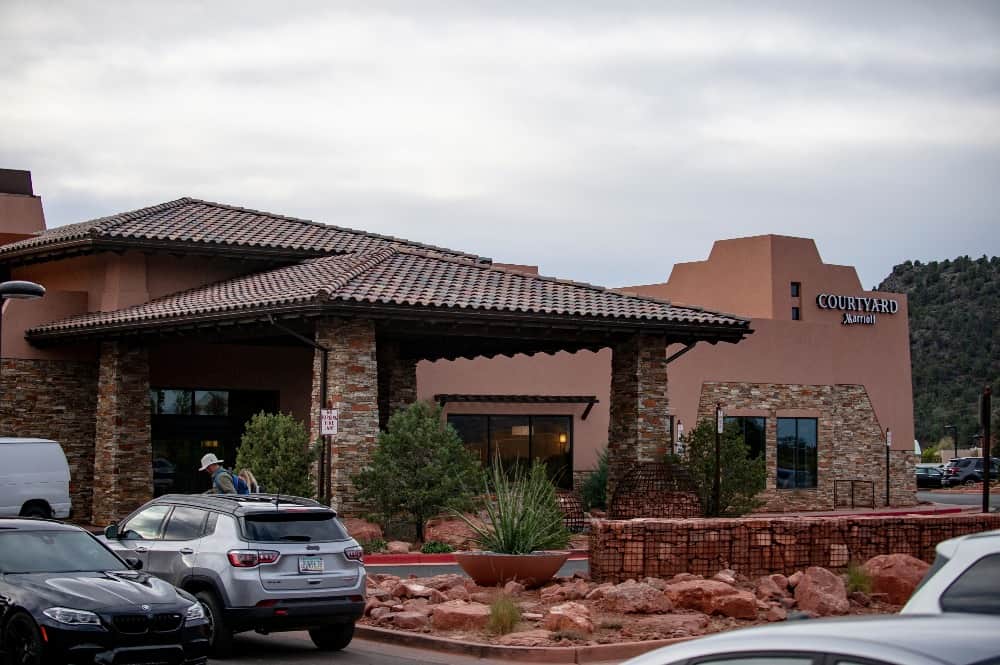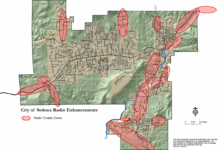What a difference a few minutes makes. As the Sedona City Council was finishing up three hours of discussion on the proposed Marriott Residence Inn, it was anyone’s guess as to how the vote was going to go. But in the end, the developer sweetened the pot in terms of the amount he is willing to give to help with the local housing crisis. A zone change request for the project passed unanimously on Tuesday, Nov. 13.
In the end, developer Paul Welker agreed to give $625,000 to the city’s affordable housing fund at the time the building permit is issued and an additional $199,000 — $824,000 total — to the same fund upon receiving its certificate of occupancy. Additional community benefits are listed later in this story. The 90-room hotel will be adjacent to the existing Courtyard by Marriott, which sits at the intersection of State Route 89A and Upper Red Rock Loop Road. It will sit on just over 3 acres with an additional three-quarter acres of open space, which will be used for drainage.
The land is already zoned as lodging and was part of the original zoning change when the Marriott Courtyard was approved. However, the zoning designation of lodging requires a zone change for any project that increases the total number of lodging units on a property. The zoning approved under the current zoning allowed for a maximum of 121 lodging units for Courtyard. Therefore, to build the additional 90 lodging units, a zone change to increase this number to 211 was required. When the project was first before the city, Welker offered the following community benefits, which are required for a zone change request:
- Two employee housing units.
- Contribution of $50,000 to the city’s affordable housing fund.
- Trailhead connection to Skywalker Trail, with 15 trail parking spaces and U.S. Forest Service kiosk.
- Shuttle service for guests.
- Access easement to the city’s odor treatment facility.
- Public art.
- Other associated site improvements.
During a Sedona Planning and Zoning meeting earlier this year, the commission requested that the number of employee units be increased. Welker agreed to up that number to five and P&Z approval was granted. In September, council gave the direction that the balance of the entire project, as presented, did not appear to adequately address the Sedona Community Plan and mitigate potential impacts particularly in the area of housing. Staff was directed to continue to work with Welker to strengthen the community benefits portion of the application, a city report states.
In response to the council’s discussion during the work session, on Oct. 18, Welker’s team submitted a revised proposal for a 90-unit hotel with no on-site affordable housing and the following community benefit package along with their valuation of each:
- Trailhead development, $69,000.
- Electric car chargers, $30,000.
- Public art, $90,000.
- Easement to the city, $181,216.
- Shuttle van, $45,000.
- In-lieu fee contribution of $726,069.98, paid over 10 years.
- Applicable fee waivers of $53,700.
This offer would mean no employee housing at the hotel but $726,000 for the affordable housing fund. Shortly into Tuesday’s meeting, however, Welker offered to give half that amount up front and the rest over four years, or $625,000 in one lump sum. This came on the heels of council members stressing how urgent the housing crisis is now and that something needs to be done sooner than later. The city does not currently have a plan in place as to how to use those housing funds, which will be more than $1 million after Welker’s contribution.
However, it has had some fairly elaborate planning conversations about potential projects, City Manager Justin Clifton said following the meeting.
“Housing is a huge challenge to us and a huge priority,” Councilwoman Jessica Williamson said.
“It may not have been as big of an issue two years ago. Affordable housing has been an issue but it’s been exacerbated over the last couple of years. I just see the council as fulfilling its obligation and its charge to identify the most pressing community benefits that will serve the widest community now.”
As noted, Welker agreed to give $824,000 toward the housing fund. But that amount includes the monetary equivalency of the trailhead development, car charging stations, shuttle van and all but $35,000 set aside for public art at the request of the majority of the council. These items will no longer be part of the community benefits. When Welker built the adjacent Courtyard at Marriott, one of his community benefit contributions was $25,000 for the housing fund.
It was pointed out that at that time, Sedona was not facing the same housing issues it is now, which council and others attribute to short-term vacation rentals now being allowed in Sedona thanks to Senate Bill 1350. The housing issue has resulted in the city increasing its use of its Development Incentives and Guidelines for Affordable Housing policy. This provides guidelines and offers incentives to encourage the construction and retention of affordable housing in Sedona. It specifies that the city will consider an in-lieu fee as an alternative to constructing affordable housing units. These guidelines specify that collected in-lieu fees will be deposited into the city’s dedicated affordable housing fund.
Councilman John Currivan said the DIGAH is very clear that it’s a voluntary program. Yet, he said the city seems to be using it as if it were mandatory.
“Even though it says it’s voluntary I wonder if the way we’re handling this, if applicants really see this as being voluntary,” he said.
“If you tell an applicant that it’s voluntary but on the other hand if you don’t do it, we’re not going to approve your project, maybe it’s still voluntary under the law but I’m not sure the applicants would view this as a voluntary program.”
He also said that while city priorities change, the city’s housing issue isn’t necessarily Marriott’s problem. “The numbers we’re playing with here — whether it’s $726,000, $625,000 or $800-something, these are all very substantial numbers, especially compared to what came up in the Courtyard deal,” he said.
“I think the number being proposed is a very reasonable one.”
Mayor Sandy Moriarty said she agreed with other members of the council in that they wanted to maximize the amount of money dedicated to the housing fund instead of other benefits. The idea of giving those funds to Habitat for Humanity was raised. While she said it’s a worthwhile organization, she would hesitate in earmarking all the money for one organization.
“Housing, as we all recognize today, is the most important thing,” she said. “I want to mention that the DIGAH has always been a voluntary process. It’s never been mandatory — it can’t be by state law.”





















